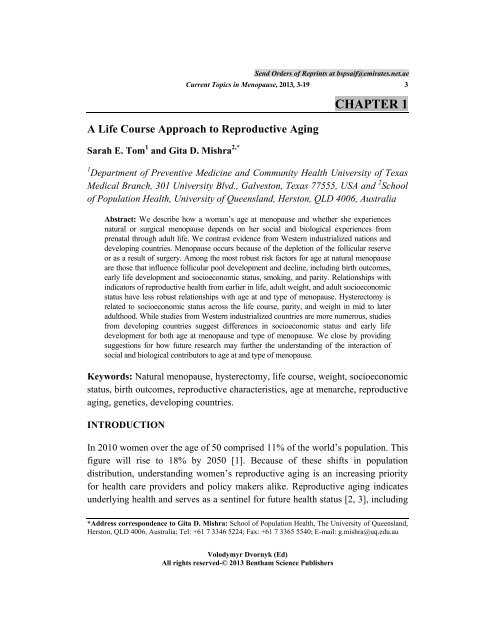Download - Bentham Science
Download - Bentham Science
Download - Bentham Science
Create successful ePaper yourself
Turn your PDF publications into a flip-book with our unique Google optimized e-Paper software.
Current Topics in Menopause, 2013, 3-19 3<br />
A Life Course Approach to Reproductive Aging<br />
Sarah E. Tom 1 and Gita D. Mishra 2,*<br />
CHAPTER 1<br />
1 Department of Preventive Medicine and Community Health University of Texas<br />
Medical Branch, 301 University Blvd., Galveston, Texas 77555, USA and 2 School<br />
of Population Health, University of Queensland, Herston, QLD 4006, Australia<br />
Abstract: We describe how a woman’s age at menopause and whether she experiences<br />
natural or surgical menopause depends on her social and biological experiences from<br />
prenatal through adult life. We contrast evidence from Western industrialized nations and<br />
developing countries. Menopause occurs because of the depletion of the follicular reserve<br />
or as a result of surgery. Among the most robust risk factors for age at natural menopause<br />
are those that influence follicular pool development and decline, including birth outcomes,<br />
early life development and socioeconomic status, smoking, and parity. Relationships with<br />
indicators of reproductive health from earlier in life, adult weight, and adult socioeconomic<br />
status have less robust relationships with age at and type of menopause. Hysterectomy is<br />
related to socioeconomic status across the life course, parity, and weight in mid to later<br />
adulthood. While studies from Western industrialized countries are more numerous, studies<br />
from developing countries suggest differences in socioeconomic status and early life<br />
development for both age at menopause and type of menopause. We close by providing<br />
suggestions for how future research may further the understanding of the interaction of<br />
social and biological contributors to age at and type of menopause.<br />
Keywords: Natural menopause, hysterectomy, life course, weight, socioeconomic<br />
status, birth outcomes, reproductive characteristics, age at menarche, reproductive<br />
aging, genetics, developing countries.<br />
INTRODUCTION<br />
Send Orders of Reprints at bspsaif@emirates.net.ae<br />
In 2010 women over the age of 50 comprised 11% of the world’s population. This<br />
figure will rise to 18% by 2050 [1]. Because of these shifts in population<br />
distribution, understanding women’s reproductive aging is an increasing priority<br />
for health care providers and policy makers alike. Reproductive aging indicates<br />
underlying health and serves as a sentinel for future health status [2, 3], including<br />
*Address correspondence to Gita D. Mishra: School of Population Health, The University of Queensland,<br />
Herston, QLD 4006, Australia; Tel: +61 7 3346 5224; Fax: +61 7 3365 5540; E-mail: g.mishra@uq.edu.au<br />
Volodymyr Dvornyk (Ed)<br />
All rights reserved-© 2013 <strong>Bentham</strong> <strong>Science</strong> Publishers
















